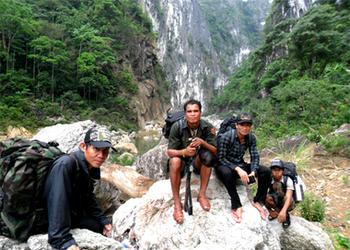Context
Laos has 24 national protected areas and two wildlife corridors, more than most other Southeast Asian countries. Together they cover 15 per cent of Laos’ total surface area. Numerous smaller conservation forests also exist at provincial and district levels, which increase the total land area under protection to more than 20 per cent.
Located on the Lao-Vietnamese border, the Hin Nam No National Protected Area covers 88,500 hectares and is part of one of the largest karst regions in the world. Hin Nam No’s landscape is spectacular, marked by unique limestone formations. It is home to endangered monkeys, deer, leopards and more than 520 plant species. About 20 villages are located around this national protected area. They have a combined population of 7,000 people (2005), many of whom belong to ethnic minorities. Most of these people are very poor and rely on natural resources from within the protected area and on its margins, which provide up to 40 per cent of their nutritional and domestic needs. Poaching, illegal logging and the weakness with which protected area regulations are enforced are putting pressure on Hin Nam No’s sensitive ecosystem. While there is growing awareness at the national level of the need to protect biodiversity, at the local level the technical, financial and human resources for managing and protecting the nature reserve remain inadequate.
The project in the Hin Nam No region is part of the programme ‘Climate-relevant environment and resource management in Laos’.
Objective
The NPA Management Authority and local communities conserve the biodiversity of the Hin Nam No (HNN) National Protected Area through a mutually agreed, co-management approach. Villagers have participated in establishing natural resource management plans and they actively take responsibility for the protected area through conservation agreements. Food security and alternative sources of income have improved.
Approach
The project is based on the principles of collaborative management, bringing together the intermediaries (authorities) and the target group (local population) to deal with the protection and administrative tasks at hand. This co-management approach is an innovation in Laos. Villagers form co-management committees with a mandate to protect and manage the natural resources in and around Hin Nam No, in accordance with an approved co-management plan.
The project supports its partner in improving its expertise for district administration. At the same time, it is developing collaborative management instruments with which to facilitate cooperation among all the stakeholders in the protected area and to provide a model at the national level. In this way, it is helping to harmonise planning for the protected area with the district and provincial plans.
To improve the economic situation of the local population, the project is engaged in development partnerships with the private sector to establish ecotourism products and promote their commercial application in and around the nature reserve. It also promotes measures to conserve nature and generate incomes. Designation as an ASEAN Heritage Park and UNESCO world heritage site would raise international awareness, while making it easier to secure funding and promote tourism.
Another key project component involves the provision of advice to the partner on improving the protected area management structures. This follows the introduction of administrative reforms and the identification of roles and tasks at the provincial and district level.
The consulting firm IP Institut für Projektplanung GmbH supports the implementation of the project.
Results achieved so far
The Hin Nam No management and governance structures are assessed each year in accordance with the internationally recognised guidelines of the International Union for Conservation of Nature (IUCN). The 2015 assessments of governance and of management demonstrated four per cent and nine per cent improvements respectively in the measured values, compared to the baseline values assessed in 2014. Nineteen democratically elected village co-management committees with 87 members have been officially approved by the district governor. They took up their work in May 2015. Co-management committees at the district level have also been approved and now meet on a regular basis. Technical working groups have been formed to support the committees.
Villagers and park authorities have received training to familiarise them with the protected area regulations. Today, they carry out joint patrols in the area. The Xe Bang Fai Cave has been made accessible to visitors, with villagers providing services such as guided tours. Green Discovery, an eco-travel agency, now also offers tours to the protected area. Further eco-tourism products have been developed, such as nature trails like the Mu Gia pass and the Ho Chi Minh Trail in the north of Hin Nam No. Groups have also been established and trained for the provision of tourism services. By means of a new ticketing system, entry to Hin Nam No is now controlled, and income is generated for the protected area and the villagers, as well as the tourism and district authorities.
The ‘Spatial Monitoring and Reporting Tool’, a participatory instrument for monitoring biodiversity, is now used regularly and is helping to improve the management of the protected area.
The project has assisted with the training of 110 officially recognised village rangers. These people are now able to monitor the indicator species and threats in Hin Nam No. This is a positive step, but threats still remain to the biodiversity which make regular patrols and monitoring by local village rangers essential.
Meanwhile, the creation of fish conservation zones in three villages also contributes to the sustainable use of natural resources.

